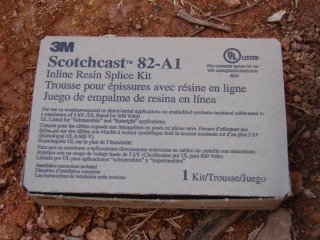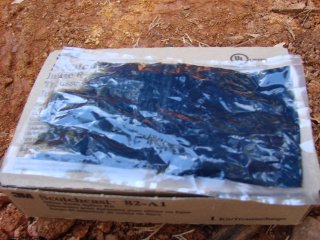» Home
» Electrical Wiring Directory
» How to Splice Electrical Wires
» Need Electrical Help? Ask the Electrician
» Need Electrical Help? Ask the Electrician
Electrical Repairs - Part 2
 |
Summary:
The Scotch Cast repair kit provides maximum protection for the electrical wiring repairs and moisture proofing for direct burial electrical cable. This kit is available in a wide variety of sizes for several applications.
© By: Dave Rongey |
Features using the 3M Scotchcast for Electrical Repair of Cables
CAUTION: Identify your Power Source and make SURE the Power is OFF!
Ground Repair for Electrical Cables
Here is a quick overview of electrical-wiring repairs using the Scotch Cast Repair Kit.
Electrical Repairs using the 3M Scotchcast Kit |
|
 |
 |
| The Scotchcast repair kit comes as a complete kit. This type of kit is ideal for performing an inline cable-repair where there may not be a lot of slack in the cable. | This kit uses resin as a protective enclosure to keep the cable repair dry and safe from damage. Once the repair is ready the resins are mixed together. |
| Position the individual wires so that the wire connectors can be staggered so they don't take up too much room inside the enclosure. |   |
 |
Once the wires are positioned the two halves of the enclosure are placed together. Notice that the wires pass straight thorough the enclosure openings at each side. The kit comes with rubber tape to wrap around the ends of the enclosure to prevent the resin from escaping. I have also wrapped the enclosure with electrical tape as well. Two plastic funnels are inserted into the openings at the top of the enclosure. After mixing the two resins together according to the instructions, a corner is torn away and the resin mixture is poured into the protective cable repair enclosure. The two openings help to fill the enclosure and allow the air to leave the enclosure. |
| Once the resin mixture has filled the enclosure I wrap electrical tape across the openings to close up the enclosure. As the resin cures the enclosure will warm up until the drying time is complete. |
|
|
||||||||||
The Safest Way to Test Electrical Devices and Identify Electric Wires!The Non-Contact Electrical TesterThis is a testing tool that I have had in my personal electrical tool pouch for years, and is the first test tool I grab to help identify electrical wiring. It is a Non-contact tester that I use to easily Detect Voltage in Cables, Cords, Circuit Breakers, Lighting Fixtures, Switches, Outlets and Wires. Simply insert the end of the tester into an outlet, lamp socket, or hold the end of the tester against the wire you wish to test. Very handy and easy to use.
The Quickest Way to Check for Faulty Electrical Wiring!The Plug-In Outlet TesterThis is the first tool I grab to troubleshoot a problem with outlet circuit wiring. This popular tester is also used by most inspectors to test for power and check the polarity of circuit wiring. It detects probable improper wiring conditions in standard 110-125 VAC outlets Provides 6 probable wiring conditions that are quick and easy to read for ultimate efficiency Lights indicate if wiring is correct and indicator light chart is included Tests standard 3-wire outlets UL Listed Light indicates if wiring is incorrect Very handy and easy to use.
Strip Off Wire Insulation without Nicking and Damaging the Electric Wire!The Wire Stripper and Wire CutterMy absolute favorite wire stripping tool that I have had in my personal electrical tool pouch for years, and this is the tool I use to safely strip electrical wires. This handy tool has multiple uses: The wire gauges are shown on the side of the tool so you know which slot to use for stripping insulation. The end of the tool can be used to grip and bend wire which is handy for attaching wire onto the screw terminals of switches and outlets.. The wire stripper will work on both solid and stranded wire. This tool is Very Handy and Easy to Use. |
||
Residential Electrical Parts and AccessoriesLight Switches 120volt Outlets Circuit Breakers Electrician Tools Voltage Testers |















